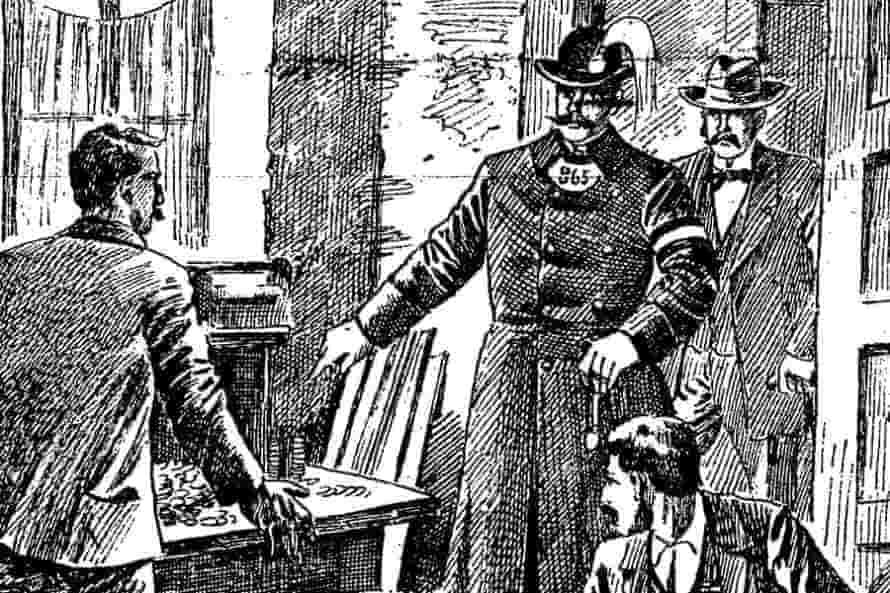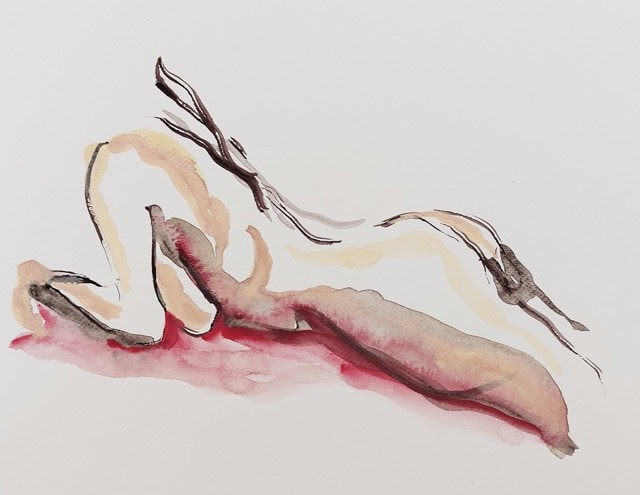In one of our earlier articles we wrote about the system of police records from the beginning of the 20th century, and the related museum which was still not accessible to the public then, where not only successful captures were showcased but evidence of several unsolved cases too. One such case was the crime of passion committed in Víziváros on 24 June 1898, on which numerous contradictory statements were published in the press.
On the afternoon of 24 June 1898 the body of an elderly woman (her age reported at both 62 and 80 in the news) was found by workers near the Roderer crypt in the civilian cemetery next to the military cemetery in Víziváros. Naturally, the police were notified immediately, and they established foul play beyond doubt.
The murder was first reported in the Pesti Napló, which published its first daily summary on 25 June according to which:
“An incised wound of 4 cm was found on the right side of the neck, whereas on the left side of the sternum another puncture wound of 2 cm was visible with sharp edges, and three more stabs in the abdomen each of which were by all means fatal. The pockets of the dead body were turned inside-out, and a thin black string on the neck was broken, which brings us to the conclusion that after the killing, the murderer also robbed the victim.
The identity of the victim is still unknown. One of the policemen arriving at the scene recognised the woman as an unemployed and homeless tramp, but was unable to say her name. The launched investigation found that a tall, thin, blond and shabby-looking woman was seen in the cemetery this afternoon. The police believe in all likelihood that she is the murderer and has issued a warrant. During the night, several suspicious individuals were taken to the police station, but the murderer has yet to be captured.”[1]

It is worth taking some time to introduce the crime scene since the cemetery in Víziváros originally had nothing to do with Víziváros itself.
It is common knowledge that at that time, the name Buda referred to the Castle Hill, Víziváros as it is known today, and the Tabán park, so in the Middle and early Modern Ages cemeteries were established accordingly. As the city expanded, however, several graveyards were relocated (there are examples of this even from the 1960s). The first cemetery in Víziváros was opened in 1695 on today’s Szász Károly utca.
This was closed down after the plague of 1739-1740 – after which it was long referred to as the Plague Cemetery – and a new graveyard was created in Medve utca.
Once this filled up, the people of Buda started to bury their dead in the eastern corner of Városmajor park, at the junction of Szilágyi Erzsébet fasor and today’s Széll Kálmán tér from around 1760. These were eliminated by the end of the 19th century and the site was built on.
The military cemetery of the garrison (where General Hentzi is buried among others) was near Déli pályaudvar. After this cemetery filled up, a new site opened between Szilágyi Erzsébet fasor, Virányos út and Kútvölgyi út in 1785. Ignác Martinovics, Ferenc Verseghy and Vörösmarty’s daughters were laid to rest here, and in 1797 the military graves were relocated here too. The cemetery was officially closed in 1885, but was only finally eliminated in the 1930s. But now back to the investigation!
On 26 June the Pesti Napló reported on the successful identification of the victim.
Her landlord came forward and told the police that the elderly day-labourer or working woman was widow Podolszky Alajosné, born Anna Wend (or Wendl). It also transpired that she left to pray at her father’s grave at 2.00 pm on 24 June.
“She had no money or jewellery on her, and she could not have had more than a few kreutzers with her. The pouch, where she kept her wealth of only a few kreutzers, was found empty among the graves. On her neck she wore a small tin amulet, which the murderer might have mistaken for silver and this invaluable object could have served as a motive for the killing. Mrs. Podolszky received 3 forints in benefit from the municipal poverty fund.” [2]
The article also revealed that investigators were not sitting idle, since by then they had already interrogated two tramps: István Dosits and another who went by the nick(?)name of Emmár. Although it was not proven that they committed the crime, they were held in custody for a while, just in case.
The article of the daily paper Magyarország reported about the event in similar terms, although it did not mention any tramps, and the victim’s details are different too.
“The police have so far been unable to identify the murderer, but the review of the investigation today provided us with the following details: forensic experts have not yet carried out the autopsy on the victim’s body in the robbery homicide that happened in the Víziváros Cemetery yesterday because the institute has not yet been requested to do so.
The murdered woman was identified by the investigation as widow Alajosné Podolszky, 62, born in Budapest as Anna Vend, a domestic worker and residing with János Keller at Üröm-utcza 34. As she was unemployed, she lived on aid from the almshouse. Yesterday she visited her husband’s grave at the cemetery on the anniversary of his death.” [3]

It was a difficult investigation at that time: there were no witnesses, and although the police in Budapest were pioneering in the use of modern investigation techniques, they could not apply them to a great extent here.
Dactyloscopy was spreading at the time, but for such a test you needed 1) usable fingerprints at the crime scene, 2) an extensive database, which was only at a developing stage at the time, and/or a suspect, whose fingerprints could be compared to the ones found at the scene.
The autopsy mentioned in the article above was finally carried out, and it revealed that the case believed so far to be a robbery murder or a robbery gone wrong, was even more brutal than previously assumed.
On 27 June the Pesti Napló wrote this:
“The body of Podolszky Alajosné, the elderly woman murdered in the Víziváros Cemetery, was dissected on Sunday morning. Doctors wanted to identify the cause of death when they found with great surprise that the murderer had already carried out an “autopsy” with near-medical precision on the poor woman’s body. Forensic doctors found that the killer aimed the first stab at the back of the victim’s head. This piercing cut, which was 8 cm deep, was without doubt fatal. However, the ghastly job of the murderer had only just began. Clearly practised, the killer cut the ribs of the old woman and opened the chest to see the heart.
Then he pierced the woman’s heart with his knife before cutting up her left and right armpits and finishing the job with a terrible cut at the abdomen of the corpse.
The murderer cut the abdomen of the woman from the lower parts up to the chest, then all across at the hip, essentially opening up the entire cavity. Scarcely had a corpse with such mutilation perpetrated by human hands lain on the marble table of the Üllői út morgue.
While compiling the autopsy report, the doctors’ suspicion only became stronger that this was not a simple robbery homicide, but it was much more likely that Mrs Podolszky was the victim of a so-called crime of passion, similarly to those unfortunate girls executed by Jack The Ripper in Whitechapel, London. It is possible that the murder was committed out of superstition by a hobo or gypsy turning up out of nowhere because the corpse reveals wounds similar to the ones found in the latest murder cases in Germany.
The police investigation so far has focused on mapping the personal relationships of the murdered woman, namely her lifestyle, the people she was in touch with, especially those whom she had recently contacted, since it can not be ruled out that the victim knew the murderer. The woman’s body was laid in a coffin on Sunday afternoon and was taken to the morgue of the Kerepesi út cemetery and will be buried on Monday afternoon.” [4]
It is clear that the investigators are still in the dark, but the press has already found links to both Jack The Ripper and to similar German cases.
The criminal who became known as Jack The Ripper killed and mutilated 5 prostitutes in Whitechapel in London between August and November of 1888. British investigators were also puzzled, and the names arose of several suspects, from a beast committing blood libel to mad artists, and even members of the Royal Family were suspected. Since his identity is still unknown, he is still an active subject of historians’, criminologists’ and detectives’ interest, but his character often appears in novels, films and series too.
His murders were widely reported on by Hungarian newspapers: besides Pesti Hírlap, Budapesti Hírlap and Vasárnapi Újság (national daily papers), Borszem Jankó (a political magazine) and even the Protestáns Egyházi és Iskolai Lapok (Protestant Church and School Magazine) wrote about Jack The Ripper, although the latter only in an article flogging sensationalist tabloid news. One thing is certain though, that if the murderer read newspapers, he could easily have heard about the case, which might have served as “inspiration”.
Reports were published on the German cases too: for instance, in 1891 the Pesti Hírlap provided details of a murder in Aachen, which was carried out with similar brutality.

The above also lets us in on the fact that, although not in an institutional sense, but at least through the press, law enforcement officers of different countries did cooperate in some form.
The autopsy and the investigation was reported on by the Magyarország daily as well. Besides describing the wounds, this article went as far as assuming that it could have been a ritual killing, but the newspaper is much more optimistic on the anticipated results of the investigation.
“Despite conducting the fiercest of investigations the police has hitherto been unable to capture the killer, although they already have information, which makes it highly probable that they can catch the murderer soon. (…) A number of suspects have already been arrested, but with the exception of one or two, most of them were released after the interrogations due to the lack of evidence.” [5]
On 27 June the Budapest Hírlap published a similar report, but when mentioning ritual killings they did not make any assumptions about the ethnicity of the perpetrator.
With a similar line of thought they also commented on the Berlin killings, from which we may draw the conclusion that there might have been several killers “operating” with Jack The Ripper style killing methods (or downright copycat criminals). [6]
Remember though that we are around 15 years after the Tiszaesztár “blood libel” lawsuit, so it is only understandable that many people’s interest was aroused by the investigation. As time passed it became more and more likely that the murderer would not be found. In the 29 June issue of Magyarország the failure of the investigation was highlighted, but some interesting clues were also published. The article confirms that the news of a robbery homicide was true after all as the old lady’s jewellery were taken.
The police therefore issued an announcement saying:
“The following valuables were stolen from widow Podolszki Alajosné, who was robbed and murdered in the Víziváros cemetery on 24 June 1898:
I. A pair of small golden lens-shaped earrings, the purchase value of which was 4 forints years earlier.
II. An oval copper medallion from a pilgrimage site with the picture of Maria and the «Maria, Mutter der immerwehrenden Hilfe» round inscription on one side. The other side has the picture of Saint Alphonsus with the inscription «Heil. Alfonsius» — «Maria hitt für uns». We hereby call upon all those who come into possession of any information on the sale or pawning of these objects (a valuable item and a medallion), to provide the nearest policeman with the name and identity of those selling or pawning the valuables.”[7]

It cannot be excluded that the criminal tried to disguise the murder as robbery, although no mention of this appears in the newspapers.
Even if this line of inquiry did not bring any results, for a short while it seemed that another line of clues might lead the police to the culprit. Similarly to today’s investigations, the police first looked for the perpetrator among the friends and family of the victim, since it is much more likely that one such person had a motive for the killing.
“The police raided the city daily and around 100 hobos were captured, but the robber/murderer was not among them. The closest relative of the victim, her nephew Ferenc Podolszky, did not show up at the funeral. The police noticed this and detectives were looking for him everywhere yesterday.
Then today brought an unexpected twist in the story as the murderer was allegedly caught. Police have not yet notified the press about this, but it might only be because the investigation is not closed yet.
This afternoon the guard at the Víziváros Cemetery told a woman visiting the cemetery that Mrs Podolszky’s killer was arrested and it is none other than Ferenc Podolszky himself. At the time of the bloody murder, two boys were stealing cherries from one of the trees of the cemetery, when they suddenly noticed that an elderly woman and a young man were loudly arguing not too far from them.
The young man was asking for money, but the woman refused and started weeding the grave. Then the youngster stabbed her in the back of her neck, and when she collapsed, he stabbed her several other times. The two boys hid silently on the tree, and only came down when the murderer disappeared.
They were so scared that they only told their mothers about this gruesome scene today, who of course immediately called the police. The description of the person by the boys fitted Ferenc Podolszky perfectly, who was found and arrested this afternoon, so says the cemetery guard. How true his story is may only be revealed tomorrow.”[8]
– the events are recounted by the Budapest Hírlap on 30 June.
The argument between the two might have given rise to the murder, but it does not necessarily explain its outstanding brutality.
In any case, Ferenc Podolszky was later released. No newspaper reported on whether he was acquitted because of a lack of a criminal act or just evidence. It was the Magyarország on 3 July that brought up the case again. Beside the previous police announcement, the paper reported on details of the time of the murder too.
“Mrs. Podolszky left her home at 2:00 pm on 24 June. By 3:00 pm she arrived at the cemetery and was found dead around 6:00 pm. So the murder happened between 3:00 and 6:00 pm. At the time many people were also in the cemetery, mainly workers cutting the grass, and some other visitors.
Those interrogated so far could not provide any positive details. The police disclosed the description of the stolen objects – a pair of lens-shaped golden earrings and a Saint Alphonsus medal (sic!) – but nobody contacted them with any information about the sale of these items. The police now is offering a reward of HUF 100 for anyone who can provide any information leading to the identity of the murderer.”[9]

The case, however brutal, was soon ignored by the newspapers and was mentioned with decreasing frequency.
But the public maintained an interest in the story, which showed how poor public security was considered in the area, or at least, to use a trendy modern phrase, it demonstrated the subjective sense of security of the locals.
The press covered bad security conditions of the area on several occasions. It was a relatively scarcely populated neighbourhood favoured by the homeless and all sorts of dubious figures, who were understandably not well-liked by the citizens of Buda.
The idea of doubling police forces and establishing new stations in the capital city also emerged, other people only wanted a pay-rise for policemen as a way of reinforcing motivation.
The Budapest Hírlap reported on Béla Rudnay police chief’s efforts to calm the residents of Zugliget on 6 July.
“The other day a meeting was held by the Zugliget association, which found public security in Zugliget worryingly bad, and it decided to raise its voice towards the competent authorities to secure the physical and material safety of its people. Today the police chief will make an extended statement about the issue, listing all the crimes that have occurred in Zugliget and Svábhegy since the beginning of May.
In his report he mentioned the Víziváros cemetery, as the scene of a robbery homicide, besides which 4 poultry and half a sack of flower seed, two peacocks, one suitcase, a table cloth, five table covers, two gypsum figures, some coffee pots, 8 forints, a silver watch, a gold watch, one gold ring and a pair of silver pendants were stolen from various places. The thieves were all captured.
With 15,000 holiday-makers, says the chief, public safety is not bad based on the listed cases, excluding the robbery homicide.
It is more important to improve wages than to increase the number of police, the current headcount is sufficient enough to keep law and order. Besides others the police chief promises to increase the number of police patrols on Svábhegy and Zugliget.”[10]
Having heard the above list of crimes, and considering that many others were not even reported at that time, it is understandable how dumbfounded people of the neighbourhood – who “grew up” with peacock thefts and similar petty crimes – were when they heard the news of a robbery and/or crime of passion.
The Magyarország which reported on this meeting also published a sharp-toned article about the crimes that did not reach the authorities.
“According to these statistics, only minor thefts occurred on a land of many thousand hectares within 2 months, excluding the murder in the Víziváros Cemetery. The police chief listed a set of ridiculously petty occurrences and separately mentions at least 10 times for each case that the perpetrator had been caught, but he says nothing about recent highway robberies and assaults in the area. We would also like to hear the above sentence, “The perpetrator was caught”, repeated in the case of the robbery homicide in the Víziváros Cemetery.”[11]

These were definitely tough times for the police chief, if not for anything else but for the fact that a week later he had to go to a hearing at the public administration committee, and although he tried to highlight the results, he also needed to report on several difficult cases, not just the cemetery murder.
“Today the police chief appeared in front of the Metropolitan Public Administration Committee reporting on an eventful June from the perspective of the police. He considered public security in the last month to be adequate, although 1,346 crimes were recorded, among others a murder at the District 4 police station, the Víziváros robbery homicide, four robberies and a large-scale embezzlement at the post office.
The police chief complained about the newspapers which reported about fictitious or richly “embellished” robberies. He listed Károly Mester’s case as fiction, although initially the police believed the young man was strangled with a loop and stabbed, when it turned out the second day that Mr Mester plotted the romantic robbery himself.
He also mentioned the fact that the countless tales of robberies have scared the people of Budapest so much that they now demand the establishment of many new police stations, which could only be feasible by doubling the number of policemen. He received letters from the countryside asking him if it is safe to travel to the capital.”[12]
Nonetheless, another piece emerged on the Jack the Ripper of Zugliget in August, and at one point it even seemed likely that the killer had been found.
On 24 August the Budapest Hírlap reported as follows:
“Police reports this summer abound in sensations: no less than three robbery homicide cases happened, which is too many, even if we consider the harsh winter and growing unemployment. In June an elderly woman was murdered in the Víziváros cemetery and 20 kreutzers were stolen from her, 20 days earlier a worker was killed for 2 forints at the side of the railway embankment in Rákospalota, and tonight an ill-fated young woman was fatally wounded for her small fortune. All these crimes happened on the periphery, and owing to the commendable zeal of the police all but one of the culprits were captured.”[13]

On 30 June the same newspaper gave details on the capture of a certain Bálint Farkas, who was interrogated as a suspect in the case of Mrs. Podolszky’s murder, but was able to prove his alibi.
It is only a minor issue that the article falsely reported the date of the murder as 18 June.
“Two months ago widow Podolszky Alajosné, 60, was murdered and robbed in the Víziváros Cemetery on 18 June, but the attacker has still not been found as the personal description lacks sufficient detail. Yesterday, police finally thought they had captured the long-wanted criminal. They arrested a man called Bálint Farkas, who was wanted for embezzlement charges.
The investigating police chief found numerous suspicious circumstances that made it probable that Farkas killed the old housemaid. He was interrogated all through yesterday into today before it was finally confirmed that Farkas is innocent of the murder as he could prove that he was not in Budapest at the time of the crime.”[14]
The crime of passion at the Víziváros Cemetery is still unsolved today: the criminal might have been among the suspects, but no evidence was found against them (either because of a mistake or the level of technology at the time), or the culprit might never have come to the attention of the police. We can only hope that no more people fell victim to this criminal.
Reference
[1] Pesti Napló 25 June 1898, p. 9
[2] Pesti Napló 26 June 1898, p. 9
[3] Magyarország 26 June 1898, pp. 7-8
[4] Pesti Napló 27 June 1898, p. 4
[5] Magyarország 27 June 1898, p. 5
[6] Budapesti Hírlap 27 June 1898, p. 4
[7] Magyarország 29 June 1898, p. 8
[8] Budapesti Hírlap 30 June 1898, p. 4
[9] Magyarország 3 July 1898, p. 7
[10] Budapesti Hírlap 6 July 1898, p. 9
[11] Magyarország 6 July 1898, p. 7
[12] Budapesti Hírlap 12 July 1898, p. 7
[13] Budapesti Hírlap 24 August 1898, p. 7
[14] Budapesti Hírlap 30 August 1898, p. 7
The old cemeteries of Víziváros
Tracing forgotten cemeteries in Budapest
Opening picture: policemen at work at the turn of the century (illustration)





